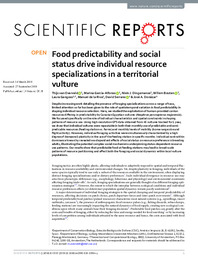Por favor, use este identificador para citar o enlazar este ítem:
https://hdl.handle.net/11000/6007Registro completo de metadatos
| Campo DC | Valor | Lengua/Idioma |
|---|---|---|
| dc.contributor.author | Overveld, Thijs van | - |
| dc.contributor.author | García Alfonso, Marina | - |
| dc.contributor.author | Dingemanse, Niels J. | - |
| dc.contributor.author | Bouten, Willem | - |
| dc.contributor.author | Gangoso, Laura | - |
| dc.contributor.author | de la Riva, Manuel | - |
| dc.contributor.author | Serrano, David | - |
| dc.contributor.author | Donázar, José A. | - |
| dc.contributor.other | Departamentos de la UMH::Biología Aplicada | es |
| dc.date.accessioned | 2020-05-12T09:30:17Z | - |
| dc.date.available | 2020-05-12T09:30:17Z | - |
| dc.date.created | 2018-10-11 | - |
| dc.date.issued | 2020-05-12 | - |
| dc.identifier.uri | http://hdl.handle.net/11000/6007 | - |
| dc.description.abstract | Despite increasing work detailing the presence of foraging specializations across a range of taxa, limited attention so far has been given to the role of spatiotemporal variation in food predictability in shaping individual resource selection. Here, we studied the exploitation of human-provided carrion resources differing in predictability by Canarian Egyptian vultures (Neophron percnopterus majorensis). We focussed specifically on the role of individual characteristics and spatial constraints in shaping patterns of resource use. Using high-resolution GPS data obtained from 45 vultures tracked for 1 year, we show that individual vultures were repeatable in both their monthly use of predictable and semi-predicable resources (feeding station vs. farms) and monthly levels of mobility (home range size and flight activity).However, individual foraging activities were simultaneously characterized by a high degree of (temporal) plasticity in the use of the feeding station in specific months. Individual rank within dominance hierarchy revealed sex-dependent effects of social status on resource preference in breeding adults, illustrating the potential complex social mechanisms underpinning status-dependent resource use patterns. Our results show that predictable food at feeding stations may lead to broad-scale patterns of resource partitioning and affect both the foraging and social dynamics within local vulture populations | es |
| dc.description.sponsorship | TVO received funding from the European Union’s Horizon 2020 research and innovation programme under the Marie Sklodowska-Curie grant agreement No. “SocForVul 659008”. | - |
| dc.description.sponsorship | The long-term monitoring of the vulture population has been funded by the projects REN 2000–1556 GLO, CGL2004-00270/BOS, CGL2009-12753-C02-02, CGL2012-40013-C02-01, and CGL2015-66966-C2-1-2-R (Spanish Ministry of Economy and Competitiveness and EU/FEDER) | - |
| dc.description.sponsorship | Further support was provided by, the Cabildo Insular de Fuerteventura and the Dirección General de Protección de la Naturaleza (Viceconsejería de Medio Ambiente, Canarian Government | - |
| dc.format | application/pdf | es |
| dc.format.extent | 13 | es |
| dc.language.iso | eng | es |
| dc.rights | info:eu-repo/semantics/openAccess | es |
| dc.subject.other | 573 - Biología general y teórica | es |
| dc.title | Food predictability and social status drive individual resource specializations in a territorial vulture | es |
| dc.type | info:eu-repo/semantics/article | es |
| dc.identifier.doi | 10.1038/s41598-018-33564-y | - |
| dc.relation.publisherversion | Https://doi.org/10.1038/s41598-018-33564-y | - |

Ver/Abrir:
13-van Overveld et al. 2018 Scientific Reports.pdf
1,92 MB
Adobe PDF
Compartir:
 La licencia se describe como: Atribución-NonComercial-NoDerivada 4.0 Internacional.
La licencia se describe como: Atribución-NonComercial-NoDerivada 4.0 Internacional.
.png)